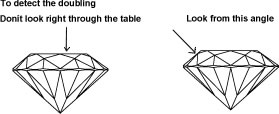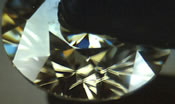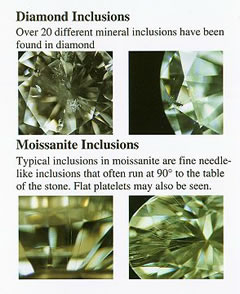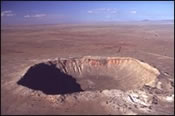 Fifty thousand years ago, long after this creature had vanished, a meteorite crashed into the Arizona desert creating what is now known as “Meteor Crater.” Fragments of this meteorite were scattered across the desert. Hidden in these fragments was a brilliant secret waiting to be discovered. In 1893, Nobel-Prize winning scientist Henri Moissan began studying fragments of this meteorite in nearby Diablo Canyon. In these fragments Dr. Moissan discovered minute quantities of a shimmering new mineral, with fire and brilliance never before seen on earth. After extensive research, Dr. Moissan concluded that this mineral was made of silicon carbide.
Fifty thousand years ago, long after this creature had vanished, a meteorite crashed into the Arizona desert creating what is now known as “Meteor Crater.” Fragments of this meteorite were scattered across the desert. Hidden in these fragments was a brilliant secret waiting to be discovered. In 1893, Nobel-Prize winning scientist Henri Moissan began studying fragments of this meteorite in nearby Diablo Canyon. In these fragments Dr. Moissan discovered minute quantities of a shimmering new mineral, with fire and brilliance never before seen on earth. After extensive research, Dr. Moissan concluded that this mineral was made of silicon carbide.
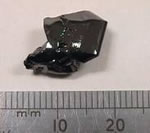 For over a hundred years the stone was little more than a footnote in research books. Then, in 1995, Cree Inc. a US based company that manufactures silicon carbide devices developed a synthetic Moissanite from silicon carbide crystals.
For over a hundred years the stone was little more than a footnote in research books. Then, in 1995, Cree Inc. a US based company that manufactures silicon carbide devices developed a synthetic Moissanite from silicon carbide crystals.
 Naturally occurring Moissanite, from which the jewels are made, is dark green or black, found in very limited quantities and is not commercially viable. Cree discovered a process of taking the minerals silicon and carbon, evaporating them into one compound, then growing them into a crystal. This crystal is cut into the final Moissanite jewel, either nearly colorless, like a diamond, or in various shades of green.
Naturally occurring Moissanite, from which the jewels are made, is dark green or black, found in very limited quantities and is not commercially viable. Cree discovered a process of taking the minerals silicon and carbon, evaporating them into one compound, then growing them into a crystal. This crystal is cut into the final Moissanite jewel, either nearly colorless, like a diamond, or in various shades of green.
 In 1995, one of the principals involved with Cree founded a company, C3, which was to be later renamed Charles and Colvard. It was this company that for three years developed the process of creating synthetic Moissanite and the following manufacturing of the stones, before hitting the consumer market with the latest “diamond substitute” in 1998. During that first year, Charles and Colvard recorded Moissanite sales of some $4 million. This more than tripled in the second year to over $12.2 million in 1999, continuing to increase to $12.7 million in 2000.
In 1995, one of the principals involved with Cree founded a company, C3, which was to be later renamed Charles and Colvard. It was this company that for three years developed the process of creating synthetic Moissanite and the following manufacturing of the stones, before hitting the consumer market with the latest “diamond substitute” in 1998. During that first year, Charles and Colvard recorded Moissanite sales of some $4 million. This more than tripled in the second year to over $12.2 million in 1999, continuing to increase to $12.7 million in 2000.
Near colorless, Moissanite has physical properties very similar those of diamond. For example, Moissanite tests positive for diamond on conventional thermal probes. Almost all diamond simulants share one property with diamonds: they are singly refractive. A ray of light passing through the gem is slowed but otherwise unaffected by the medium. Synthetic Moissanite is doubly refractive. This means that a ray of light passing through the stone is slowed, bent and split in two as it passes through it.
To the average eye Moissanite seems virtually as beautiful as a diamond, though its color is lower. At first sight, both inside and on the surface, Moissanite’s brilliance seems to be softer and cloudier. The sharp effects of the color spectrum in a regular diamond are enticing and the human eye easily registers the stone’s distinct nuances. On the other hand the color spectrum effects in Moissanite are more spread out. On the hardness scale, Moissanite is only slightly softer than diamond, registering 9+ on the Mohs scale, as opposed to a diamond’s 10.
 Moissanite, along with other synthetic and treated stones now account for a little over two percent of the diamond jewelry market.
Moissanite, along with other synthetic and treated stones now account for a little over two percent of the diamond jewelry market.
Moissanite costs about one-tenth of its diamond counterpart. A one-carat Moissanite stone set in 14-karat gold would retail for somewhere around the $700 market, compared to a one-carat diamond in an identical setting, which, depending on the quality of the stone, would retail from $4,500 to $6,000. Mercifully for the diamond market, since the first introduction of the stone to consumers, marketing of the stone has been focused away from promoting it as a diamond imitation, rather as a gem in its own right. In fact many of the stores and online sites selling Moissanite jewelry don’t even mention diamond or diamond substitute.
Detecting Moissanite
 Testers: Since Moissanite tests positive on a standard electronic Diamond Tester, a special Moissanite Testers can be used to identify Moissanite
Testers: Since Moissanite tests positive on a standard electronic Diamond Tester, a special Moissanite Testers can be used to identify Moissanite
Conventional diamond testers test for thermal conductivity and are useful in separating diamond from simulants such as cubic zirconia, corundum, glass, synthetic rutile, and zircon. Thermal diamond testers cannot be used to discriminate diamond from moissanite, because both are thermally conductive.
An electrical conductivity tester, designed specifically for testing Moissanite, will indicate Moissanite and would ideally be used after a thermal diamond tester has eliminated other simulants.
Polished Girdles: The outside edge which runs around the crown of a cut stone is called the “girdle.” Sometimes girdles are polished, but more than often they are faceted on diamonds. Moissanite has polished girdles, and although this method cannot be used alone, in conjunction with other methods it helps to separate Moissanite from Diamonds.
Gemological Certifications: Most diamonds today come with certifications from laboratories such as AGS, GIA or EGL. The one sure way to know you are purchasing diamond and not moissanite is to buy from a reputable dealer who offers certified diamonds.
Doubling: When Moissanite viewed through a 10X jeweler’s loupe, it will show signs of “doubling.” If you view the stone through the crown or pavilion (underside) facets, and you look to the other side of the stone, the opposite back facet edges will appear doubled, like parallel train tracks set close together. Diamond is singly refractive, and therefore does not show doubling.
Almost all diamond simulants share one property with diamond; they are singly refractive. The term “singly refractive” means that a ray of light passing through the gem is slowed but otherwise unaffected by the material. Glass is a singly refractive material, as are cubic zirconia, garnet and diamond itself.
Synthetic moissanite is doubly refractive. This means that a ray of light passing through this sort of gem is slowed, bent and split in two as it passes though the medium. Sapphire is a doubly refractive material, as are peridot, tourmaline and zircon.
The effect of double refraction becomes visible, for example in peridot or zircon, when the back facets of the stone are viewed through the table. There seem to be two of every facet and the culet. This effect is called doubling.
One aspect of doubly refractive material is that every doubly refractive gem has at least one direction in which the material appears to behave like a singly refractive gem (called the optic axis), and does not break light into two rays. Synthetic moissanite is cut so that this direction of single refraction is though the table. This means that the doubling is not apparent when the stone is viewed though the table.
Moissanite must be viewed through any other crown facet (e.g. star, or bezel) to see the doubling. The doubling seen through these other facets is very strong, almost fuzzy in appearance.
Therefore, when examining a “diamond” after testing it with the thermal probe, tilt the stone slightly and look at the culet and the other pavilion facets through one of the crown facets other than the table. No doubling, it’s a diamond. If you see doubling it is not a diamond.
Inclusions: Another technique for detecting synthetic moissanite is to look at the stone’s inclusions. A synthetic moissanite may have distinctive sub-parallel needle-like inclusions or ‘stringers’ oriented perpendicular to the table.
Moissanite may also have rounded facet junctions and polish lines that run in the same direction on adjacent facets. Under magnification, moissanite does not exhibit “bearding” or “naturals.” Bearding, minute fissures in a diamond’s girdle, occur in the cutting process. Naturals are growth characteristics in a diamond. The absence of bearding and naturals does not separate moissanite from other diamond simulants, and not all diamonds exhibit bearding.


